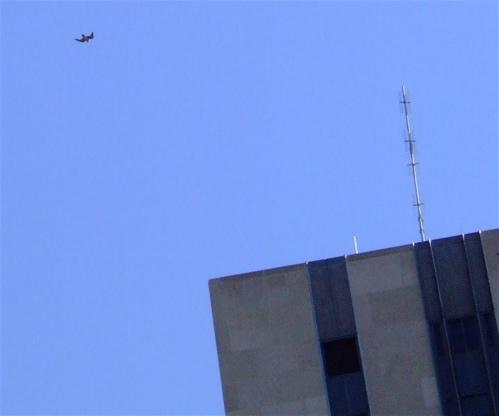 Boy, spring hormones are kicking in with the local peregrine falcons. I was walking from the Mississippi National River & Recreation Headquarters to the visitor center in downtown St Paul when I heard a familiar "Per-chup per-chup per-chup." Sure enough, the local breeding peregrines were circling and diving towards each other. It didn't look like territory battle, but more display and pair bond reaffirmation.
Boy, spring hormones are kicking in with the local peregrine falcons. I was walking from the Mississippi National River & Recreation Headquarters to the visitor center in downtown St Paul when I heard a familiar "Per-chup per-chup per-chup." Sure enough, the local breeding peregrines were circling and diving towards each other. It didn't look like territory battle, but more display and pair bond reaffirmation.
While I was at headquarters, a co-worker showed me a nest that had been collected on one of the islands in our national park near the Twin Cities metro area. She found it last fall and when she first described it to me, I couldn't figure out what was going on. It was a nest that was covered with cotton, but had a perfectly round hole on top. What could that be? I finally got to see it today.
At first glance, I realized that it was two nests, one stacked on top of the other. This could have been done for a couple of different reasons, maybe a bird decided to build on a nest from the previous year? Or, I wondered, if the bottom nest started as maybe a warbler nest and then a cowbird laid an egg and the warbler decided to start over with a new nest on top? I asked my co-worker if I could pull them apart and she seemed hesitant, but then said it was okay.
I pried them slightly apart and low and behold, there were two eggs hidden in the bottom nest. Now, here was the question, are these cowbird eggs or are these the original nest builder eggs? For the non birders who read this blog, brown-headed cowbirds do not raise their own young, they are a parasitic birds and lay eggs in other species' nests. Sometimes you will see a small bird like a yellow warbler feeding a brown bird twice its size. That is a young cowbird that has been raised by unknowing birds.
I set one of the eggs on a ruler to measure it. It looked to be about 5cm long. I'm going to have to go home and look up the length of cowbird eggs vs warbler and sparrow eggs. Based on where the nest was found, the most likely candidates for who made it would be song sparrow, yellow warbler, or common yellowthroat. I'm not that great at nest id and I don't have any of my nest books with me. Are these the nest builder's eggs or are these cowbird eggs?
We looked into the nest on top where there was some cotton looking material and a hole. At first I wondered if a mouse had covered up the top cup and used the double nest as a home, but then realized that the cotton looking layer was mostly likely the lining for that nest, put in by the birds that built it. The hole was probably made by a mouse or rodent, perhaps it could smell the eggs underneath and went to investigate? Perhaps there were originally more than two eggs and the mouse ate some (then decided they were old and nasty and not worth eating more).
So many questions left unanswered with this mystery nest, but quite a few stories in there as well.
















